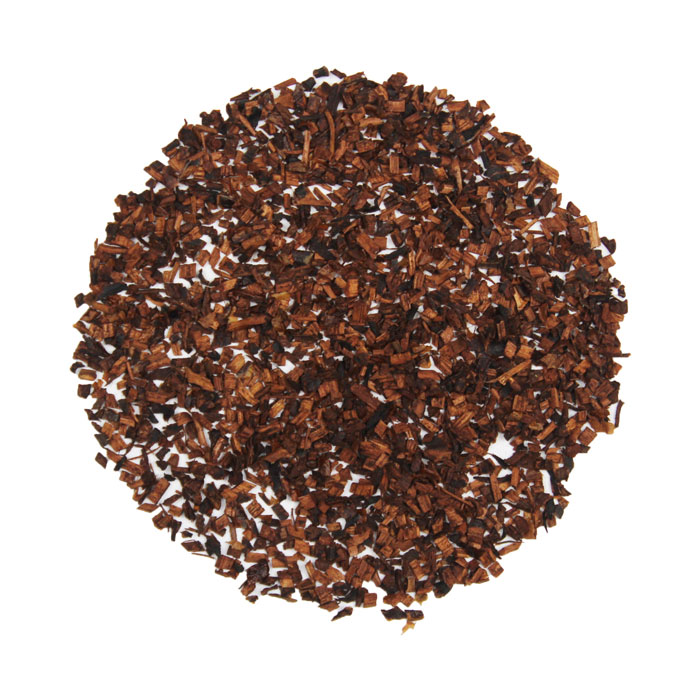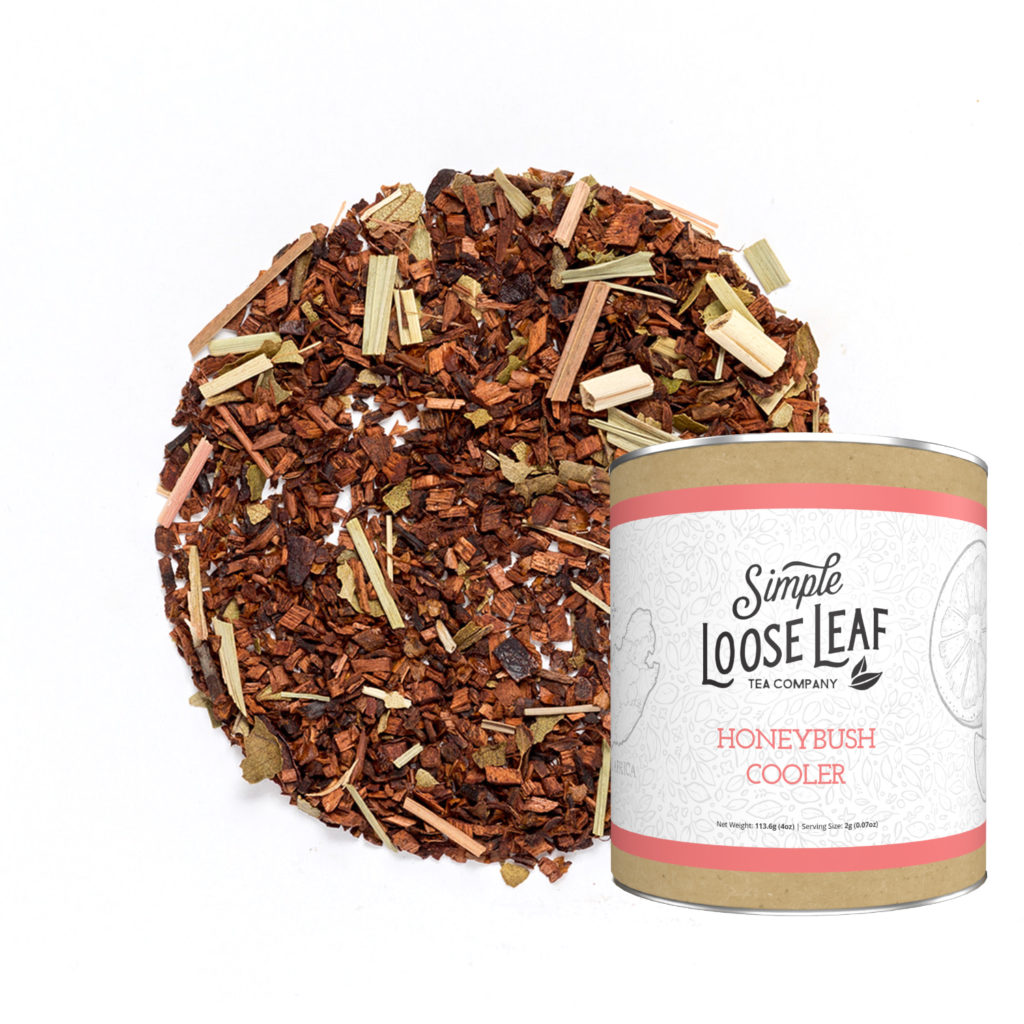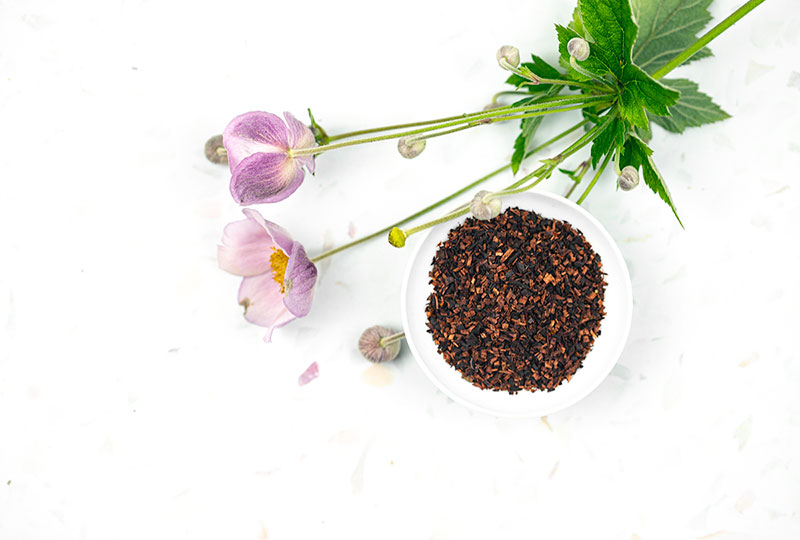Honeybush Tea Benefits and Side Effects
This post may contain affiliate links. Simple Loose Leaf is a participant in the Amazon Associates Program, an affiliate advertising program designed to provide a means for sites to earn advertising fees by linking to Amazon.com. Honeybush is a tea with one of the most attractive names in the world of herbal teas. It’s indigenous to South Africa and growing mostly in the wild. What makes honeybush special, what are the potential benefits and how to brew a cup of this tea?
What is honeybush tea?
Honeybush is a South African herbal tea made from the Cyclopia plant. Just like rooibos or red bush tea, it grows only in South Africa. The name comes from the scent of Cyclopia yellow flowers, that smell similar to honey[1]. However, tea itself is made from leaves of the Cyclopia plant. Once oxidized and processed, they look very similar to rooibos tea. There are 23 different Cyclopia species[2], and only some of them are widely used for commercial purposes,[3] for example, cyclopia intermedia or mountain tea, cyclopia genistoides or coastal tea and cyclopia subternata or valley tea. The most common honeybush tea is fermented with a dark orange-brown color. However, just like rooibos it can be green too, or unfermented. Once the leaves are harvested, they are cut into small pieces, moistened, fermented and dried[4]. Plants are harvest once per year or even once in every few years. But the most interesting part is that most of honeybush tea is harvested from wild plants[5], meaning they are completely organic, even though they don’t have a certification. Honeybush is mostly exported to Europe and the United States, with the Netherlands and Germany being the biggest consumers of this tea[6].
Pure honeybush herbal tea
Health benefits of honeybush tea
A cup of honeybush tea contains antioxidants, mostly mangiferin, isomangiferin and hesperidin[7], minerals and very low levels of tannins. Traditionally, it has been used for treating lungs and breathing related diseases such as tuberculosis and catarrh[8]. Benefits of honeybush tea will greatly depend on the species too. There are no known side effects of drinking honeybush tea. However, always consult your doctor before adding any new herbal tea to your diet, especially if you are under any type of medication. Benefits of honeybush tea include:-
Antioxidant properties
Antioxidants in honeybush tea may help scavenge free radicals and prevent many different diseases, provide anti-aging benefits and boost immune system[9]. Honeybush doesn’t contain the same antioxidants as rooibos tea, but may provide similar benefits. -
Aiding weight loss
Although research on weight loss properties of honeybush tea is limited, there is some evidence it may prove to be beneficial. Studies showed that honeybush may help fight obesity by lowering fat in the blood and lowering bad cholesterol[10]. -
Anti-aging properties
Honeybush may be one of the best herbal teas for fighting the signs of aging. Studies showed that honeybush extract may help with reducing wrinkles, improving skin elasticity and hydration[11]. Applying honeybush extracts topically may benefit the skin too and improve its texture and smoothness. However, the final outcome will depend on the type of honeybush plant too. For example, studies showed that cyclopia maculata honeybush tea may have a better potential to improve skin texture than cyclopia genistoides honeybush tea[12]. On the other hand, cyclopia genistoides has the highest levels of mangifering, a very potent antioxidant found in mango tree too, with dozens of potential benefits[13].
Honeybush herbal tea
-
Anti-mutagenic and anti-cancer properties
Mutations in cells are the source of many diseases and cancers. Studies showed that honeybush may be very helpful in preventing genetic mutations caused by tobacco[14] and help in prevention of esophageal,[15] breast and uterus cancers[16]. -
Phytoestrogen properties and benefits for women’s health
Honeybus tea may have phytoestrogen properties and naturally support the hormonal balance. It may help regulate the menstrual period, reduce the risk of osteoporosis[17] and help relieve menopausal symptoms[18]. Furthermore, studies showed that it may stimulate the milk production in breast-feeding women[19].
What does honeybush taste like?
Honeybush has a similar flavor to rooibos, but a tiny bit sweeter, lighter, and less earthy. It has no bitterness, and it’s very easy to brew. Honeybush can be blended with other ingredients or used pure. Unfermented green honeybush will have a less sweet grassier flavor.
Honeybush Cooler herbal tea blend
Caffeine content of honeybush tea
Honeybush is a herbal tea and just like most of herbal teas it’s naturally caffeine free. This makes it suitable for drinking at any time of the day, even before sleep.Honeybush tea vs rooibos
In many ways honeybush tea is similar to rooibos tea. They both gained a world-wide recognition about 20 years ago[20], have a similar color, contain high levels of antioxidants and even share a similar flavor profile and color.- ColorThe color of both honeybush and rooibos tea will depend on how it’s processed. Generally, honeybush is even a bit more deeper than rooibos, which may have a more intense orange-red color. Brewed tea will have darker red-brown notes, while rooibos can sometimes have a very vibrant red or red-orange color.
- LeavesLeaves of honeybush tea are a bit shorter and a bit bigger than the ones of rooibos tea. Rooibos may often look more elegant, sharp and thin, while honeybush has shorter and bigger particles.
- FlavorBecause of a very low level of tannins, honeybush will not turn bitter even when if you over-brew it. With its sweet honey-like aroma it may be more suitable for people that want a potent herbal tea with no caffeine, but don’t like the strong rooibos flavor. Green rooibos and green honeybush can be compared to green tea made from Camellia sinensis plant. They will be more grassy and fresh, but without typical green tea astringency.
How to brew honeybush tea
Brew honeybush tea in the same way you would brew rooibos tea. Use about 1 teaspoon of tea leaves per cup of water. Bring water to a boil and steep leaves for 3-8 minutes. Honeybush is available in tea bags too. You can use honeybush tea leaves to make iced tea and latte too, or cold brew it overnight.Disclaimer: This article is for informational purposes only. It’s not intended to replace medical advice, diagnosis or treatment. Every person is different and may react to different herbs and teas differently. Never use teas or herbs to treat serious medical conditions on your own. Always seek professional medical advice before choosing home remedies.
References:
[1] https://www.researchgate.net/publication/273083376_Fact_Sheet_on_Honeybush_Tea
[2] https://www.sciencedirect.com/science/article/pii/S0254629911000846 [3] https://www.researchgate.net/publication/273083376_Fact_Sheet_on_Honeybush_Tea [4] https://www.intechopen.com/books/nutraceuticals-past-present-and-future/rooibos-em-aspalathus-linearis-em-and-honeybush-em-cyclopia-em-spp-from-bush-teas-to-potential-thera [5] https://www.sciencedirect.com/science/article/pii/S0254629911000846 [6] https://www.sciencedirect.com/science/article/pii/S0254629911000846 [7] https://www.intechopen.com/books/nutraceuticals-past-present-and-future/rooibos-em-aspalathus-linearis-em-and-honeybush-em-cyclopia-em-spp-from-bush-teas-to-potential-thera [8] https://www.sciencedirect.com/science/article/pii/S0254629911000846 [9] https://www.intechopen.com/books/nutraceuticals-past-present-and-future/rooibos-em-aspalathus-linearis-em-and-honeybush-em-cyclopia-em-spp-from-bush-teas-to-potential-thera [10] https://www.intechopen.com/books/nutraceuticals-past-present-and-future/rooibos-em-aspalathus-linearis-em-and-honeybush-em-cyclopia-em-spp-from-bush-teas-to-potential-thera [11] https://www.researchgate.net/publication/322878427_Protective_effects_of_fermented_honeybush_Cyclopia_intermedia_extract_HU-018_against_skin_aging_a_randomized_double-blinded_placebo-controlled_study [12] https://www.ncbi.nlm.nih.gov/pmc/articles/PMC4653346/ [13] https://www.spandidos-publications.com/10.3892/mmr.2018.9529 [14] https://www.sciencedirect.com/science/article/pii/S0254629916302307 [15] https://www.tandfonline.com/doi/abs/10.1080/01635581.2011.539313 [16] https://cansa.org.za/files/2019/02/Fact-Sheet-on-Honeybush-Tea-February-2019.pdf [17] https://cansa.org.za/files/2019/02/Fact-Sheet-on-Honeybush-Tea-February-2019.pdf [18] https://pubmed.ncbi.nlm.nih.gov/15315375/ [19] https://www.ncbi.nlm.nih.gov/pmc/articles/PMC6321617/ [20] https://www.sciencedirect.com/science/article/pii/S0254629911000846
More from:
SLL






Leave a comment